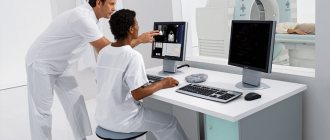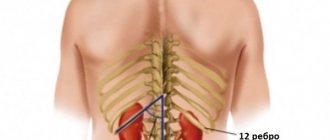MRI is the most informative, non-invasive and safe method for diagnosing kidney pathology. Its essence lies in the use of radio frequency pulses and a magnetic field.
Computer processing of the recorded signals allows one to obtain a three-dimensional image of the kidney at high resolution.
MRI is of great importance for the diagnosis of kidney disease, especially for patients who are contraindicated for radiation exposure during CT (for example, during pregnancy).
What does a kidney MRI show?
The kidneys are a paired organ of the urinary system. Located on both sides of the spinal column at the border of the lumbar and thoracic regions.
Each kidney is surrounded by fatty tissue and a fibrous capsule. The parenchyma (kidney tissue) is divided into the cortex (outer part) and the medulla (inner part). Inside the parenchyma there are cavities - cups and pelvis.
The organ has a bean-shaped shape, on the concave part there is an area where the ureter, renal vein, lymphatic vessels exit, and the renal artery and nerves (renal sinus) enter.
Kidney structure (frontal section)
MRI visualizes all these structures. The images in the transverse and frontal planes clearly differentiate the division of the parenchyma into the cortex (hyperintense signal) and the medulla (hypointense signal). The renal vessels, pyelocaliceal system and ureters are clearly visible.
Magnetic resonance imaging can also reveal:
- presence of stones;
- neoplasms and their structure;
- anatomical features and developmental anomalies;
- deviations in the condition of blood vessels;
- presence or absence of metastases.
How to do a kidney MRI
During the scan, the patient lies on a table located inside a magnetic tunnel. To obtain high-quality images, you must remain motionless throughout the entire session, which lasts about 30-40 minutes (up to 60 minutes when using contrast). The doctor, who is at this moment in the next office, can give commands to hold your breath via two-way communication. The tomograph creates noise and clicks during operation, so the staff suggests using headphones with pleasant music for better relaxation.
After the procedure is completed, the doctor prepares a description of the images within 15 minutes; they can be obtained in any convenient format.
MRI of the kidneys is normal (in T2 mode)
Indications and contraindications for MRI of the kidneys
Clinical symptoms of kidney pathology for which magnetic resonance scanning is prescribed:
- recurring pain in the abdomen and lower back;
- stone formation;
- urinary incontinence;
- urinary disturbance;
- hematuria (blood in the urine);
- dilation of the veins of the scrotum in adulthood;
- persistent increase in blood pressure.
MRI diagnostics are indicated both during the initial examination and to clarify the diagnosis made on the basis of other research methods, especially in doubtful cases.
Magnetic resonance scanning is justified for the following pathologies:
- infectious and inflammatory processes (pyelonephritis, abscesses and phlegmon of perinephric tissue);
- urolithiasis disease;
- hydronephrosis;
- developmental anomalies;
- benign neoplasms;
- malignant tumors and metastases.
Magnetic resonance imaging shows a tumor located between the right kidney and the inferior vena cava (black arrow) that is compressing the overlying inferior vena cava (white arrow)
Hydronephrosis
This is a progressive expansion of the renal collecting system as a result of impaired urine outflow. May be congenital or acquired.
Causes of difficulty in urine flow:
- Internal - narrowing of the ureter due to changes in its wall.
- External - compression of the ureter from the outside.
Obstacles to normal urination can be created by:
- cicatricial changes in the ureters;
- tumors;
- post-inflammatory adhesive process;
- polyps;
- abnormalities in the development or location of the kidneys;
- BPH;
- enlarged lymph nodes of the retroperitoneum;
- intestinal diseases.
In young children, hydronephrosis is sometimes temporary, associated with the maturation of the kidneys, and can resolve without surgical intervention.
With this pathology, MRI makes it possible to assess the condition of the renal parenchyma and choose the optimal treatment tactics.
Polycystic kidney disease
This is a genetically determined pathology, manifested by the progressive formation of cysts in the kidneys.
Their volume and size can range from very small to gigantic.
Multiple cysts on MRI of the kidneys (indicated by arrows)
Growing cysts replace the kidney parenchyma, leading to dysfunction of the organ. Inflammatory processes may develop in them.
In 60–75% of cases, the disease can manifest itself for a long time only in arterial hypertension, which manifests itself long before a significant decrease in renal function. The presence of such a pathology in relatives is a reason for a thorough MRI examination, even in the absence of complaints.
Pyelonephritis
This is an infectious-inflammatory disease of the kidneys, in which the parenchyma and pyelocaliceal system are involved in the pathological process.
There are acute and chronic pyelonephritis, as well as:
- primary - occurs in a normal kidney;
- secondary - develops as a complication against the background of abnormalities in the development of the kidney, urolithiasis and other pathologies.
Using MRI, a destructive process in the kidney and a possible cause are identified, even in cases where other diagnostic methods are ineffective (for example, inflammation against the background of an X-ray negative stone).
Contraindications to the MRI procedure:
- pregnancy in the first trimester;
- the patient has ferromagnetic implants or foreign bodies in the tissues;
- installation of non-removable electronic devices, such as a cochlear implant, pacemaker, insulin pump and others;
- age up to 5 years;
- weight more than 130 kg or waist size more than 140 cm.
Indications for magnetic resonance imaging of the urinary organs
A kidney MRI may be ordered in the following cases:
- the presence of renal symptoms of an uncertain nature: swelling of the lower extremities, pain in the lumbar region, periodic colic, fever;
- lower back injuries;
- pathological values of urine tests;
- for the purpose of monitoring in the postoperative period;
- in the presence of deviations in the production of hormones: adrenaline, progestin, androgens;
- ineffectiveness of ultrasound diagnostics (the cause of the disease has not been found and the diagnosis has not been made);
- blood pressure surges;
- diagnosing neoplasms, searching for the location of metastases.
Despite the safety of this research method, magnetic resonance imaging has several prohibitions for the procedure:
- the presence of metal or electronic products in the patient’s body (dental metal ceramics, pacemakers, insulin pumps, implants);
- excess weight more than 150 kg (for closed tomographs);
- people suffering from a fear of closed spaces;
- epilepsy;
- pregnancy (first semester);
- the presence of severe diseases of the urinary system (when using a contrast agent).
Kidney MRI with contrast
A drug based on gadolinium salts is used as a contrast. Unlike iodine-containing products, it extremely rarely causes allergic reactions, is non-toxic, and is completely eliminated from the body within 24 hours.
The use of contrast enhancement makes it possible not only to detect a tumor, but also to determine its stage, the condition of adjacent organs, and the presence of damage to blood vessels and lymph nodes. This is due to the fact that gadolinium actively accumulates in pathologically altered tissues.
MRI of the kidneys shows a sinus tumor (left kidney)
First, an MRI without contrast is always performed, then, if it is necessary to clarify the data obtained, a scan is done against the background of intravenous administration of a contrast agent. This is especially true in the presence of any kidney tumors.
There is a classification of cystic formations based on the signs identified by the results of MRI with contrast. There are categories:
- The first (I) is a benign cyst with a thin wall, without septations or areas of compaction. Does not contrast, density is identical to water.
- The second (II) is a benign cyst with single septa and small compactions. The MRI signal intensity is lower than that of the parenchyma. Diameter less than 3 cm, accumulates contrast.
- IIF – in the cystic formation, thickening of the walls and septa is observed, focal densities are larger, but do not accumulate contrast. This category requires careful monitoring, as malignancy is possible.
- Third (III) - the walls and partitions are unevenly thickened and accumulate contrast. Surgical removal is indicated and in 50% a malignant process is detected.
- Fourth (IV) – the soft tissue contents of the cyst accumulate contrast well. As a rule, this is a malignant process.
The use of a contrast agent is contraindicated in:
- pregnancy;
- severe renal failure;
- allergies to the components of the contrast agent.
Advantages and disadvantages
Comparing kidney MRI with other types of diagnostics, the following advantages can be noted:
- The study is safe.
- The high resolution of the images allows us to detect the smallest changes in the structure of organs.
- Almost anyone can get an MRI of the kidneys, because... There are almost no contraindications for this type of research. Exceptions will be epilepsy, cardiovascular diseases, kidney failure and iron objects in the body (shards, implants, etc.). The procedure is also prohibited for pregnant women, mentally ill people and those who weigh more than 120 kg.
- MRI of the kidneys with contrast makes it possible to obtain the most comprehensive picture of the patient’s health status.
- The disadvantage of this study is its high cost.
CT or MRI of the kidneys, which is better?
CT is a faster and cheaper method and is good at detecting radiopaque kidney stones. MRI shows small parenchymal tumors, their internal structure and capsule thickness more accurately and more clearly than CT.
When examining using CT, it is impossible to clearly determine the extent of damage to the inferior vena cava. Only magnetic resonance diagnostics will show the boundaries of the tumor thrombus with an accuracy of 95 - 100% and will assess the condition of the regional lymph nodes.
When choosing an examination technique, you need to take into account that MRI provides detailed data on kidney function and the anatomical features of the urinary tract and is safe when repeated several times. It is recommended to limit the number of CT procedures (no more than two per year) due to the high radiation exposure.
The high reliability of the information obtained as a result of MRI of the kidneys is confirmed by clinical studies in the largest research institutes - even in the most complex cases, the accuracy of the results is more than 98%.
Indications for examination on a magnetic resonance imaging scanner
Reasons for referral for MRI may be as follows:
- dysfunction of the urinary system (problem with urine outflow);
- suspicion of the presence of a neoplasm;
- damage to the genitourinary organs;
- pathologies of a congenital or acquired nature.
In urology, doctors resort to the use of tomography to clarify the existing results of other types of diagnostics, in order to confirm the diagnosis, as well as as part of control measures in the postoperative period.
Residents of Rostov-on-Don and guests of the city can undergo this type of study in a diagnostic one. The clinic, equipped with a Philips Intera MRI-1.5 Tesla high-field closed tomograph, specializes in conducting MRIs covering all organs and systems.
Modern tomograph installed in









